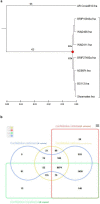Whole-genome sequence analysis of Bipolaris sorokiniana infecting wheat in India and characterization of ToxA gene in different isolates as pathogenicity determinants
- PMID: 35747503
- PMCID: PMC9209604
- DOI: 10.1007/s13205-022-03213-3
Whole-genome sequence analysis of Bipolaris sorokiniana infecting wheat in India and characterization of ToxA gene in different isolates as pathogenicity determinants
Abstract
Spot blotch disease of wheat caused by Bipolaris sorokiniana Boerma (Sacc.) is an emerging problem in South Asian countries. Whole genome of a highly virulent isolate of B. sorokiniana BS112 (BHU, Uttar Pradesh; Accession no. GCA_004329375.1) was sequenced using a hybrid assembly approach. Secreted proteins, virulence gene(s), pathogenicity-related gene(s) were identified and the role of ToxA gene present in this genome, in the development of disease was recognized. ToxA gene (535 bp) was analyzed and identified in the genome of B. sorokiniana (BS112) which revealed 100% homology with the ToxA gene of Pyrenophora tritici repentis (Accession no. MH017419). Furthermore, ToxA gene was amplified, sequenced and validated in 39 isolates of B. sorokiniana which confirmed the presence of ToxA gene in all the isolates taken for this study. All ToxA sequences were submitted in NCBI database (MN601358-MN601396). As ToxA gene interacts with Tsn1 gene of host, 13 wheat genotypes were evaluated out of which 5 genotypes (38.4%) were found to be Tsn1 positive with more severe necrotic lesions compared to Tsn1-negative wheat genotypes. In vitro expression analysis of ToxA gene in the pathogen B. sorokiniana using qPCR revealed maximum upregulation (14.67 fold) at 1st day after inoculation (DAI) in the medium. Furthermore, in planta expression analysis of ToxA gene in Tsn1-positive and Tsn1-negative genotypes, revealed maximum expression (7.89-fold) in Tsn1-positive genotype, Agra local at 5th DAI compared to Tsn1-negative genotype Chiriya 7 showing minimum expression (0.048-fold) at 5th DAI. In planta ToxA-Tsn1 interaction studies suggested that spot blotch disease is more severe in Tsn1-positive genotypes, which will be helpful in better understanding and management of spot blotch disease of wheat.
Supplementary information: The online version contains supplementary material available at 10.1007/s13205-022-03213-3.
Keywords: Bipolaris sorokiniana; Spot blotch; ToxA; Tsn1; Whole-genome sequence; qPCR.
© King Abdulaziz City for Science and Technology 2022.
Conflict of interest statement
Conflict of interestThe authors declare that they have no conflict of interest in the publication.
Figures








Similar articles
-
ToxA-Tsn1 Interaction for Spot Blotch Susceptibility in Indian Wheat: An Example of Inverse Gene-for-Gene Relationship.Plant Dis. 2020 Jan;104(1):71-81. doi: 10.1094/PDIS-05-19-1066-RE. Epub 2019 Nov 6. Plant Dis. 2020. PMID: 31697221
-
ToxA Is Present in the U.S. Bipolaris sorokiniana Population and Is a Significant Virulence Factor on Wheat Harboring Tsn1.Plant Dis. 2018 Dec;102(12):2446-2452. doi: 10.1094/PDIS-03-18-0521-RE. Epub 2018 Sep 24. Plant Dis. 2018. PMID: 30252627
-
Heterologous expression and characterization of ToxA1 haplotype from India and its interaction with Tsn1 for spot blotch susceptibility in spring wheat.Mol Biol Rep. 2023 Oct;50(10):8213-8224. doi: 10.1007/s11033-023-08717-6. Epub 2023 Aug 10. Mol Biol Rep. 2023. PMID: 37561326
-
Bipolaris sorokiniana-Induced Black Point, Common Root Rot, and Spot Blotch Diseases of Wheat: A Review.Front Cell Infect Microbiol. 2021 Mar 11;11:584899. doi: 10.3389/fcimb.2021.584899. eCollection 2021. Front Cell Infect Microbiol. 2021. PMID: 33777829 Free PMC article. Review.
-
Managing spot blotch disease in wheat: Conventional to molecular aspects.Front Plant Sci. 2023 Feb 21;14:1098648. doi: 10.3389/fpls.2023.1098648. eCollection 2023. Front Plant Sci. 2023. PMID: 36895883 Free PMC article. Review.
Cited by
-
Unraveling the dynamics of wheat leaf blight complex: isolation, characterization, and insights into pathogen population under Indian conditions.Front Microbiol. 2024 Feb 21;15:1287721. doi: 10.3389/fmicb.2024.1287721. eCollection 2024. Front Microbiol. 2024. PMID: 38450160 Free PMC article.
-
Whole Genome Sequencing and Comparative Genomics of Indian Isolates of Wheat Spot Blotch Pathogen Bipolaris sorokiniana Reveals Expansion of Pathogenicity Gene Clusters.Pathogens. 2022 Dec 20;12(1):1. doi: 10.3390/pathogens12010001. Pathogens. 2022. PMID: 36678349 Free PMC article.
-
Genetics of spot blotch resistance in bread wheat (Triticum aestivum L.) using five models for GWAS.Front Plant Sci. 2023 Jan 18;13:1036064. doi: 10.3389/fpls.2022.1036064. eCollection 2022. Front Plant Sci. 2023. PMID: 36743576 Free PMC article.
-
Genetics and breeding for resistance against four leaf spot diseases in wheat (Triticum aestivum L.).Front Plant Sci. 2023 Mar 29;14:1023824. doi: 10.3389/fpls.2023.1023824. eCollection 2023. Front Plant Sci. 2023. PMID: 37063191 Free PMC article. Review.
References
-
- Adlakha KL, Wilcoxson HD, Raychaudhury SP. Resistance of wheat to leaf spot caused by B. sorokiniana. Plant Dis. 1984;68:320–321. doi: 10.1094/PD-68-320. - DOI
-
- Aggarwal R, Das S, Jahani M, Singh D. Histopathology of spot blotch disease of wheat caused by B. sorokiniana (Teleomorph: Cochliobolus sativus) Acta Phytopathol Entomol Hung. 2008;43(1):23–30. doi: 10.1556/APhyt.43.2008.1.3. - DOI
-
- Aggarwal R, Singh VB, Gurjar MS, Gupta S, Srinivas P. Intraspecific variations in Indian isolates of B. sorokiniana infecting wheat based on morphological, pathogenic and molecular characters. Indian Phytopath. 2009;62(4):449–460.
-
- Aggarwal R, Singh VB, Shukla R, Gurjar MS, Gupta S, Sharma TR. URP-based DNA fingerprinting of B. sorokiniana isolates causing spot blotch of wheat. J Phytopathol. 2010;158:210–216. doi: 10.1111/j.1439-0434.2009.01603.x. - DOI
-
- Aggarwal R, Sharma S, Singh K, Gurjar MS, Saharan MS, Gupta S, Bashyal BM, Gaikwad K. First draft genome sequence of wheat spot blotch pathogen B. sorokiniana BS_112 from India, obtained using hybrid assembly. Microbiol Resour Announc. 2019;8(38):e00308–19. doi: 10.1128/mra.00308-19. - DOI - PMC - PubMed
LinkOut - more resources
Full Text Sources
Research Materials

